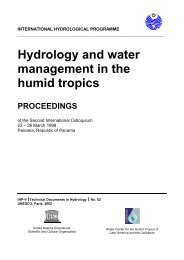FR AB - Science Reference
FR AB - Science Reference
FR AB - Science Reference
You also want an ePaper? Increase the reach of your titles
YUMPU automatically turns print PDFs into web optimized ePapers that Google loves.
emove contaminants. The bound proteins are subsequently<br />
digested with trypsin. The beads retain peptides<br />
during digestion and may be deposited directly<br />
on a target for matrix assisted laser desorption/ionization<br />
(MALDI). On-target washing may also be performed<br />
to remove substances inhibiting ionization.<br />
The method provides high-quality peptide mass fingerprint<br />
data for protein samples of only 100 nM.<br />
PROTEINS—PURIFICATION<br />
AND CHARACTERIZATION<br />
Zuo X, Speicher DW. Quantitative evaluation of protein<br />
recoveries in two-dimensional electrophoresis with<br />
immobilized pH gradients. Electrophoresis 2000;21:3035–<br />
3047.<br />
Protein recoveries are systematically evaluated at<br />
the various steps of separation by two-dimensional<br />
gel electrophoresis using immobilized pH gradients<br />
(IPGs) for the isoelectric focusing stage. The Multiphor<br />
and IPGphor systems from Amersham Pharmacia<br />
Biotech (Uppsala, Sweden) are used for the separation<br />
of metabolically radiolabeled proteins from<br />
Escherichia coli. With the Multiphor system, in which<br />
sample application to the IPG strips and subsequent<br />
electrofocusing are performed in separate vessels,<br />
sample application from cups gives better protein<br />
recoveries than sample loading by IPG rehydration. In<br />
the IPGphor system, in which sample loading and<br />
electrofocusing are performed in the same vessel, the<br />
rehydration method gives better recoveries. In all<br />
cases, carrier ampholytes in the sample buffer increase<br />
protein recoveries. Thiourea does not affect<br />
protein recoveries, but does improve protein resolution<br />
during electrofocusing.<br />
Zuo X, Speicher DW. A method for global analysis of<br />
complex proteomes using sample prefractionation by<br />
solution isoelectofocusing prior to two-dimensional<br />
electrophoresis. Anal Biochem 2000;284:266–278.<br />
Increasing the protein load on immobilized pH<br />
gradient (IPG) strips in an attempt to improve the<br />
number of visible spots resolved by two-dimensional<br />
electrophoresis is limited by the tendency of proteins<br />
to aggregate or precipitate when high protein loads<br />
are used, causing smearing in the isoelectric focusing<br />
dimension. The use of solution-phase isoelectric focusing<br />
to minimize such smearing is discussed, and an<br />
isoelectric focusing apparatus for prefractionating proteins<br />
for this purpose is described.<br />
ARTICLE WATCH<br />
Gygi SP, Corthals GL, Zhang Y, Rochon Y, Aebersold R.<br />
Evaluation of two-dimensional gel electrophoresis-based<br />
proteome analysis technology. Proc Natl Acad Sci USA<br />
2000;97:9390–9395<br />
It is widely assumed that two-dimensional gel<br />
electrophoresis, coupled with mass spectrometric<br />
identification of spots, enables a broad coverage of<br />
the proteome. Consistent with this view is the observation<br />
that the number of spots observed by twodimensional<br />
electrophoresis approaches the number<br />
of proteins predicted for a given organism or tissue.<br />
This study examines an arbitrarily selected section<br />
from a narrow pH range (4.9–5.7) two-dimensional<br />
display of yeast proteins in which more than 1500<br />
spots are visualized by silver staining. Fifty spots were<br />
digested with trypsin and analyzed by liquid chromatography<br />
combined with tandem mass spectrometry,<br />
and a total of 39 different proteins were identified<br />
from a region where the yeast genome is predicted to<br />
encode 57 gene products. However, these represent<br />
only the proteins predicted on the basis of codon<br />
usage to be the most abundant. Furthermore, only 14<br />
of the proteins identified were predicted to appear in<br />
the analyzed section. Additionally, single genes produced<br />
multiple spots, and the products of up to six<br />
genes were found to make up a single spot, presenting<br />
problems for both quantitative protein expression<br />
comparisons and database-matching studies. It is concluded<br />
that the method is unsuited for the analysis of<br />
low-abundance proteins and that statements about<br />
the feasibility and straightforwardness of proteome<br />
analysis based on the two-dimensional electrophoresis<br />
mass spectrometry strategy should be rethought.<br />
[This article has also received comment by Smith RD.<br />
Probing proteomics—seeing the whole picture. Nat<br />
Biotechnol 2000;18:1041–1042.]<br />
Ghaemmaghami S, Fitzgerald MC, Oas TG. A quantitative,<br />
high-throughput screen for protein stability. Proc<br />
Natl Acad Sci USA 2000;97:8296–8301<br />
The use of mass spectrometric measurements of<br />
hydrogen/deuterium exchange to compare the rates of<br />
denaturation of different but related proteins is<br />
described. Matrix-assisted laser desorption/ionization<br />
(MALDI) is employed to measure the rates of exchange<br />
of amide hydrogen atoms with deuterium in<br />
solution as a function of denaturant concentration to<br />
provide a measure of protein stability. The method<br />
permits large numbers of protein samples to be<br />
screened in a short time, does not demand that the<br />
proteins of interest are pure or available in large quantities,<br />
and is forgiving of the presence of denaturants.<br />
Mutants of the � repressor are studied to illustrate the<br />
JOURNAL OF BIOMOLECULAR TECHNIQUES, VOLUME 11, ISSUE 4, DECEMBER 2000 183















